MKT10724 Services Marketing: Ryanair Case Study and Strategic Review
VerifiedAdded on 2022/12/19
|8
|2375
|1
Case Study
AI Summary
This case study provides a comprehensive analysis of Ryanair's success in the airline industry, attributing it to its strong brand identity, low fares, and operational efficiency. It explores the sustainability of Ryanair's business model, considering its price-reduction strategies, ancillary revenue generation, and fleet management. The study also examines potential changes to Ryanair's approach in light of environmental concerns, emphasizing the importance of customer satisfaction and relationship building. Furthermore, it evaluates the strategic sense of Ryanair's bid for Aer Lingus, considering the objectives and outcomes of the attempted acquisition. The analysis incorporates relevant services marketing concepts, such as customer satisfaction, service quality, and the Gaps Model, to assess Ryanair's performance and offer recommendations for improvement.
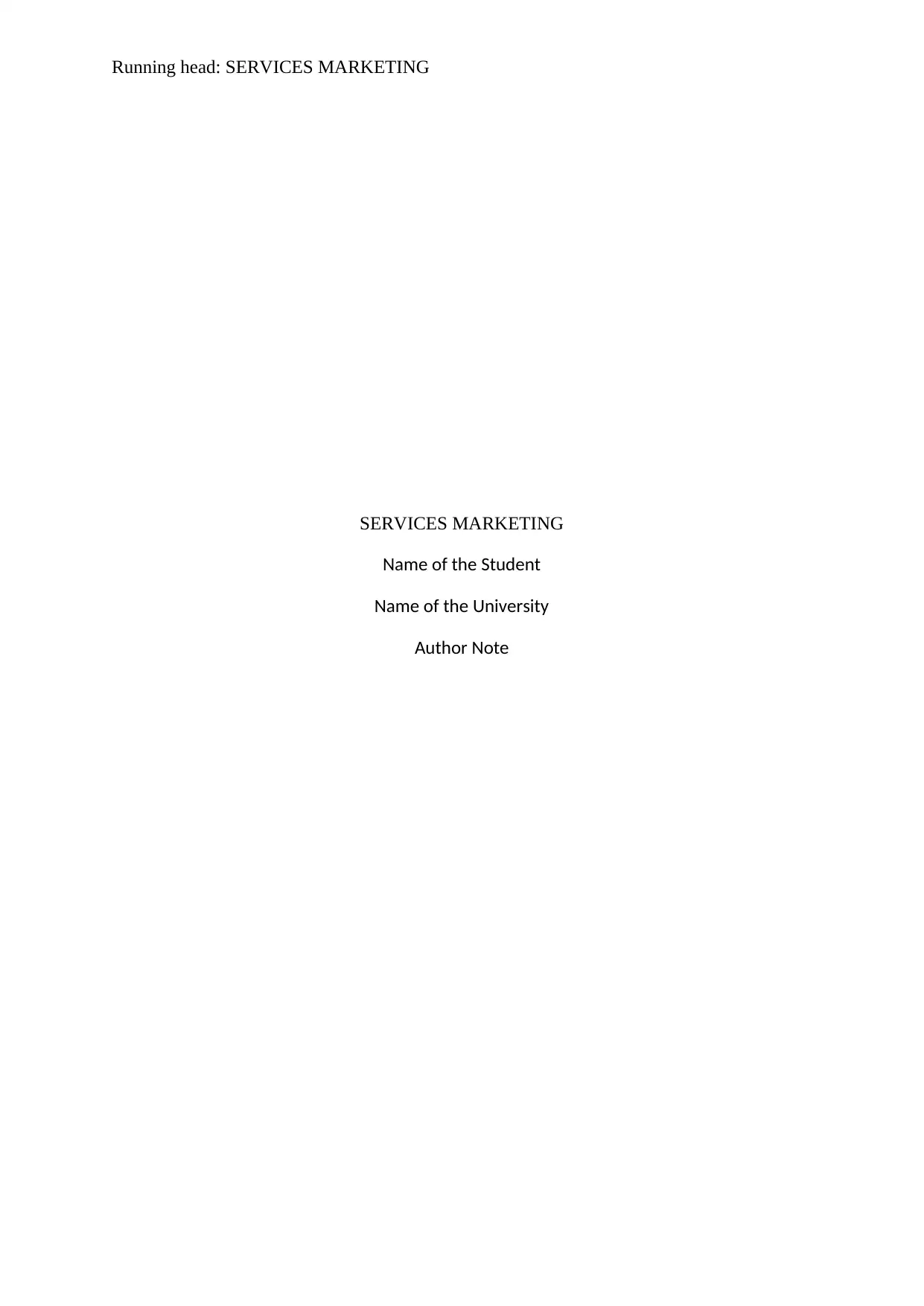
Running head: SERVICES MARKETING
SERVICES MARKETING
Name of the Student
Name of the University
Author Note
SERVICES MARKETING
Name of the Student
Name of the University
Author Note
Paraphrase This Document
Need a fresh take? Get an instant paraphrase of this document with our AI Paraphraser
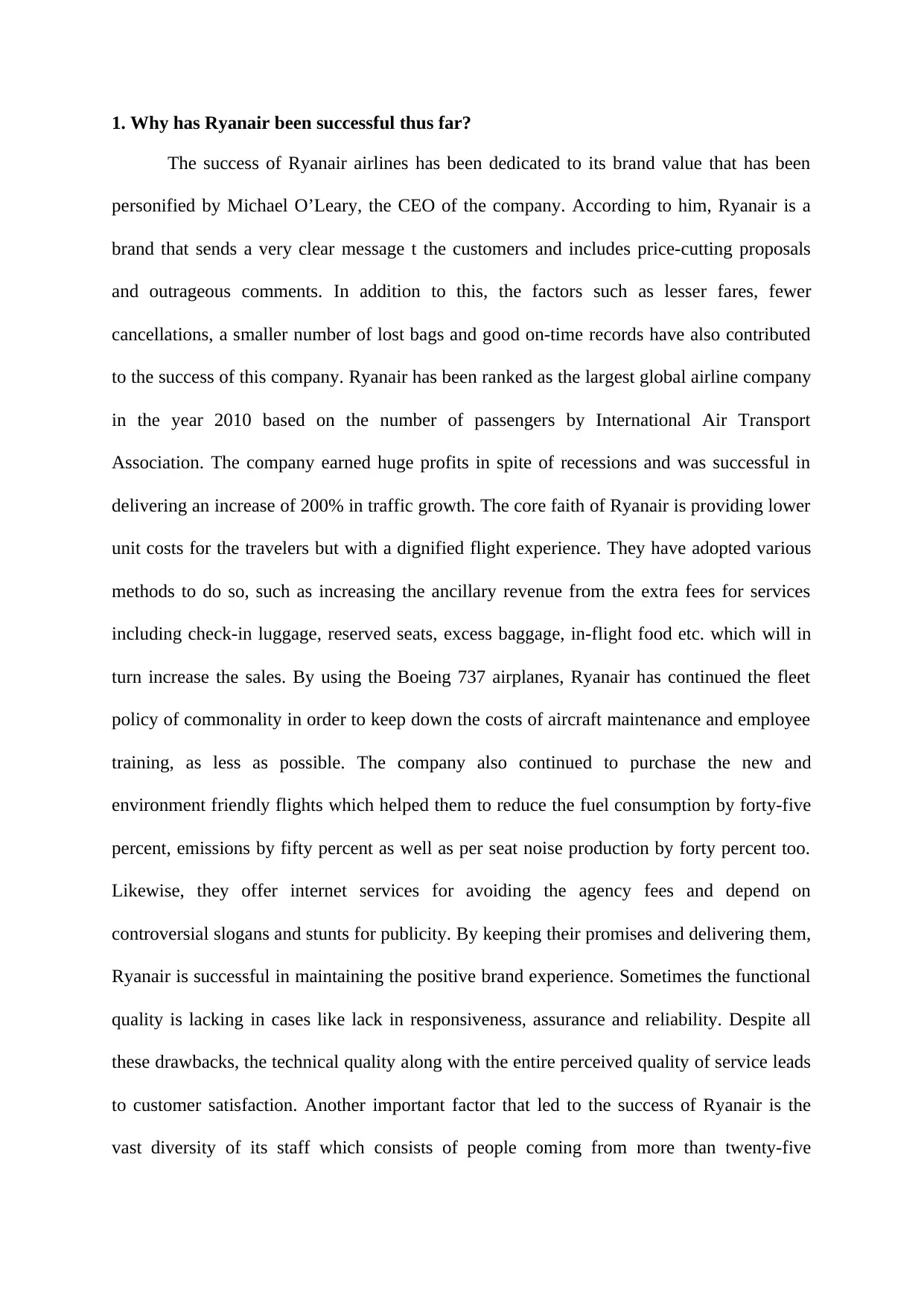
1. Why has Ryanair been successful thus far?
The success of Ryanair airlines has been dedicated to its brand value that has been
personified by Michael O’Leary, the CEO of the company. According to him, Ryanair is a
brand that sends a very clear message t the customers and includes price-cutting proposals
and outrageous comments. In addition to this, the factors such as lesser fares, fewer
cancellations, a smaller number of lost bags and good on-time records have also contributed
to the success of this company. Ryanair has been ranked as the largest global airline company
in the year 2010 based on the number of passengers by International Air Transport
Association. The company earned huge profits in spite of recessions and was successful in
delivering an increase of 200% in traffic growth. The core faith of Ryanair is providing lower
unit costs for the travelers but with a dignified flight experience. They have adopted various
methods to do so, such as increasing the ancillary revenue from the extra fees for services
including check-in luggage, reserved seats, excess baggage, in-flight food etc. which will in
turn increase the sales. By using the Boeing 737 airplanes, Ryanair has continued the fleet
policy of commonality in order to keep down the costs of aircraft maintenance and employee
training, as less as possible. The company also continued to purchase the new and
environment friendly flights which helped them to reduce the fuel consumption by forty-five
percent, emissions by fifty percent as well as per seat noise production by forty percent too.
Likewise, they offer internet services for avoiding the agency fees and depend on
controversial slogans and stunts for publicity. By keeping their promises and delivering them,
Ryanair is successful in maintaining the positive brand experience. Sometimes the functional
quality is lacking in cases like lack in responsiveness, assurance and reliability. Despite all
these drawbacks, the technical quality along with the entire perceived quality of service leads
to customer satisfaction. Another important factor that led to the success of Ryanair is the
vast diversity of its staff which consists of people coming from more than twenty-five
The success of Ryanair airlines has been dedicated to its brand value that has been
personified by Michael O’Leary, the CEO of the company. According to him, Ryanair is a
brand that sends a very clear message t the customers and includes price-cutting proposals
and outrageous comments. In addition to this, the factors such as lesser fares, fewer
cancellations, a smaller number of lost bags and good on-time records have also contributed
to the success of this company. Ryanair has been ranked as the largest global airline company
in the year 2010 based on the number of passengers by International Air Transport
Association. The company earned huge profits in spite of recessions and was successful in
delivering an increase of 200% in traffic growth. The core faith of Ryanair is providing lower
unit costs for the travelers but with a dignified flight experience. They have adopted various
methods to do so, such as increasing the ancillary revenue from the extra fees for services
including check-in luggage, reserved seats, excess baggage, in-flight food etc. which will in
turn increase the sales. By using the Boeing 737 airplanes, Ryanair has continued the fleet
policy of commonality in order to keep down the costs of aircraft maintenance and employee
training, as less as possible. The company also continued to purchase the new and
environment friendly flights which helped them to reduce the fuel consumption by forty-five
percent, emissions by fifty percent as well as per seat noise production by forty percent too.
Likewise, they offer internet services for avoiding the agency fees and depend on
controversial slogans and stunts for publicity. By keeping their promises and delivering them,
Ryanair is successful in maintaining the positive brand experience. Sometimes the functional
quality is lacking in cases like lack in responsiveness, assurance and reliability. Despite all
these drawbacks, the technical quality along with the entire perceived quality of service leads
to customer satisfaction. Another important factor that led to the success of Ryanair is the
vast diversity of its staff which consists of people coming from more than twenty-five
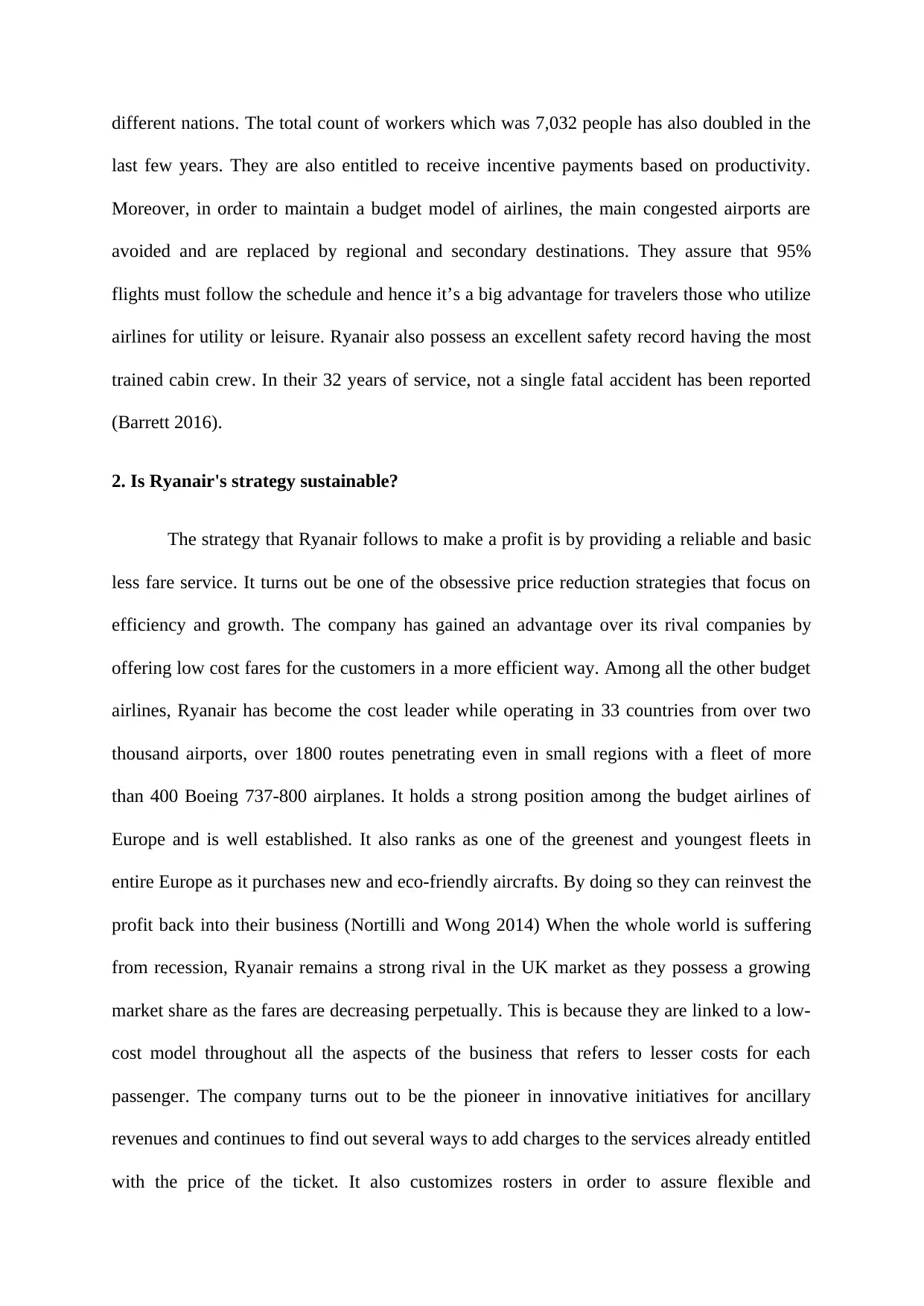
different nations. The total count of workers which was 7,032 people has also doubled in the
last few years. They are also entitled to receive incentive payments based on productivity.
Moreover, in order to maintain a budget model of airlines, the main congested airports are
avoided and are replaced by regional and secondary destinations. They assure that 95%
flights must follow the schedule and hence it’s a big advantage for travelers those who utilize
airlines for utility or leisure. Ryanair also possess an excellent safety record having the most
trained cabin crew. In their 32 years of service, not a single fatal accident has been reported
(Barrett 2016).
2. Is Ryanair's strategy sustainable?
The strategy that Ryanair follows to make a profit is by providing a reliable and basic
less fare service. It turns out be one of the obsessive price reduction strategies that focus on
efficiency and growth. The company has gained an advantage over its rival companies by
offering low cost fares for the customers in a more efficient way. Among all the other budget
airlines, Ryanair has become the cost leader while operating in 33 countries from over two
thousand airports, over 1800 routes penetrating even in small regions with a fleet of more
than 400 Boeing 737-800 airplanes. It holds a strong position among the budget airlines of
Europe and is well established. It also ranks as one of the greenest and youngest fleets in
entire Europe as it purchases new and eco-friendly aircrafts. By doing so they can reinvest the
profit back into their business (Nortilli and Wong 2014) When the whole world is suffering
from recession, Ryanair remains a strong rival in the UK market as they possess a growing
market share as the fares are decreasing perpetually. This is because they are linked to a low-
cost model throughout all the aspects of the business that refers to lesser costs for each
passenger. The company turns out to be the pioneer in innovative initiatives for ancillary
revenues and continues to find out several ways to add charges to the services already entitled
with the price of the ticket. It also customizes rosters in order to assure flexible and
last few years. They are also entitled to receive incentive payments based on productivity.
Moreover, in order to maintain a budget model of airlines, the main congested airports are
avoided and are replaced by regional and secondary destinations. They assure that 95%
flights must follow the schedule and hence it’s a big advantage for travelers those who utilize
airlines for utility or leisure. Ryanair also possess an excellent safety record having the most
trained cabin crew. In their 32 years of service, not a single fatal accident has been reported
(Barrett 2016).
2. Is Ryanair's strategy sustainable?
The strategy that Ryanair follows to make a profit is by providing a reliable and basic
less fare service. It turns out be one of the obsessive price reduction strategies that focus on
efficiency and growth. The company has gained an advantage over its rival companies by
offering low cost fares for the customers in a more efficient way. Among all the other budget
airlines, Ryanair has become the cost leader while operating in 33 countries from over two
thousand airports, over 1800 routes penetrating even in small regions with a fleet of more
than 400 Boeing 737-800 airplanes. It holds a strong position among the budget airlines of
Europe and is well established. It also ranks as one of the greenest and youngest fleets in
entire Europe as it purchases new and eco-friendly aircrafts. By doing so they can reinvest the
profit back into their business (Nortilli and Wong 2014) When the whole world is suffering
from recession, Ryanair remains a strong rival in the UK market as they possess a growing
market share as the fares are decreasing perpetually. This is because they are linked to a low-
cost model throughout all the aspects of the business that refers to lesser costs for each
passenger. The company turns out to be the pioneer in innovative initiatives for ancillary
revenues and continues to find out several ways to add charges to the services already entitled
with the price of the ticket. It also customizes rosters in order to assure flexible and
⊘ This is a preview!⊘
Do you want full access?
Subscribe today to unlock all pages.

Trusted by 1+ million students worldwide
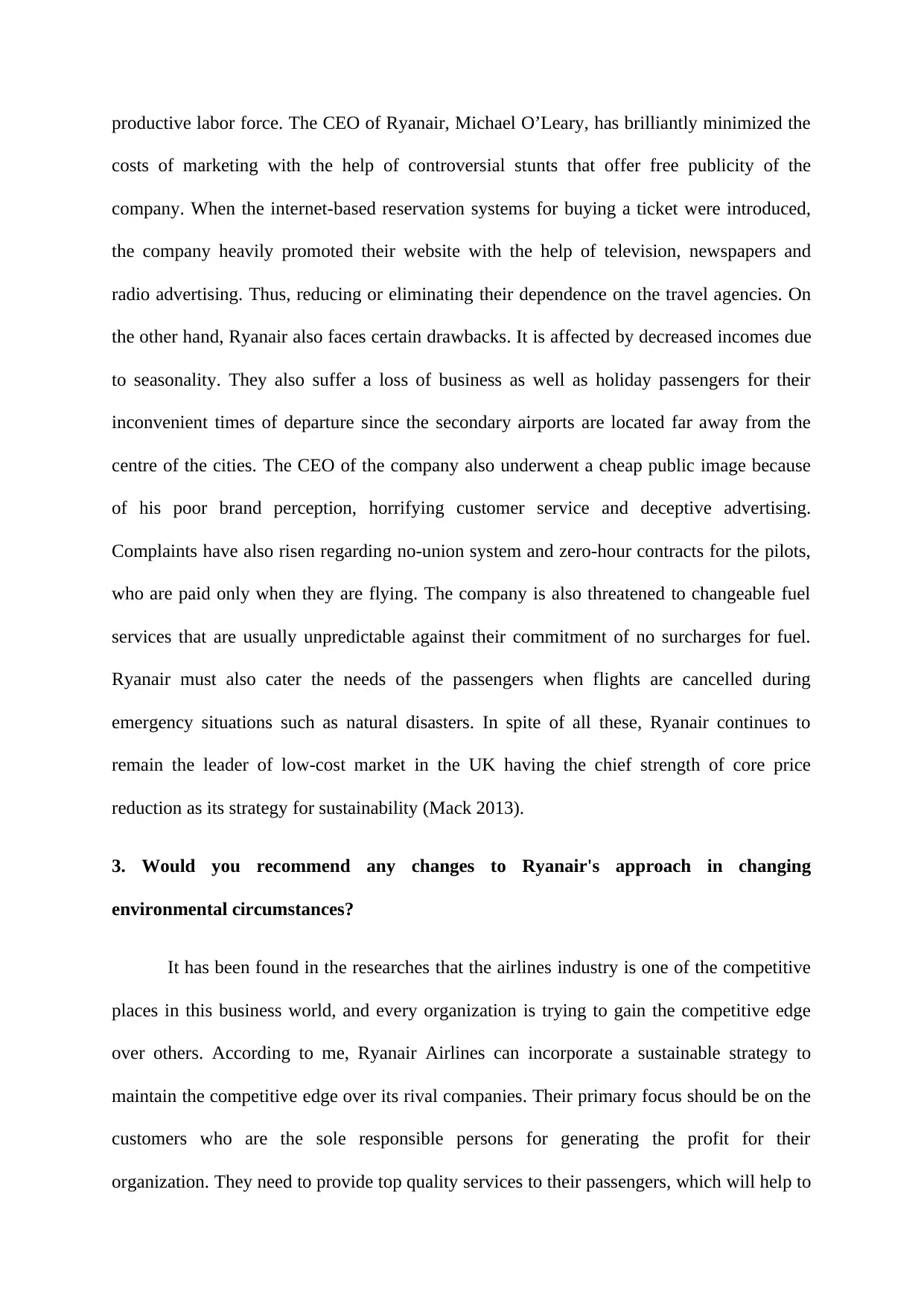
productive labor force. The CEO of Ryanair, Michael O’Leary, has brilliantly minimized the
costs of marketing with the help of controversial stunts that offer free publicity of the
company. When the internet-based reservation systems for buying a ticket were introduced,
the company heavily promoted their website with the help of television, newspapers and
radio advertising. Thus, reducing or eliminating their dependence on the travel agencies. On
the other hand, Ryanair also faces certain drawbacks. It is affected by decreased incomes due
to seasonality. They also suffer a loss of business as well as holiday passengers for their
inconvenient times of departure since the secondary airports are located far away from the
centre of the cities. The CEO of the company also underwent a cheap public image because
of his poor brand perception, horrifying customer service and deceptive advertising.
Complaints have also risen regarding no-union system and zero-hour contracts for the pilots,
who are paid only when they are flying. The company is also threatened to changeable fuel
services that are usually unpredictable against their commitment of no surcharges for fuel.
Ryanair must also cater the needs of the passengers when flights are cancelled during
emergency situations such as natural disasters. In spite of all these, Ryanair continues to
remain the leader of low-cost market in the UK having the chief strength of core price
reduction as its strategy for sustainability (Mack 2013).
3. Would you recommend any changes to Ryanair's approach in changing
environmental circumstances?
It has been found in the researches that the airlines industry is one of the competitive
places in this business world, and every organization is trying to gain the competitive edge
over others. According to me, Ryanair Airlines can incorporate a sustainable strategy to
maintain the competitive edge over its rival companies. Their primary focus should be on the
customers who are the sole responsible persons for generating the profit for their
organization. They need to provide top quality services to their passengers, which will help to
costs of marketing with the help of controversial stunts that offer free publicity of the
company. When the internet-based reservation systems for buying a ticket were introduced,
the company heavily promoted their website with the help of television, newspapers and
radio advertising. Thus, reducing or eliminating their dependence on the travel agencies. On
the other hand, Ryanair also faces certain drawbacks. It is affected by decreased incomes due
to seasonality. They also suffer a loss of business as well as holiday passengers for their
inconvenient times of departure since the secondary airports are located far away from the
centre of the cities. The CEO of the company also underwent a cheap public image because
of his poor brand perception, horrifying customer service and deceptive advertising.
Complaints have also risen regarding no-union system and zero-hour contracts for the pilots,
who are paid only when they are flying. The company is also threatened to changeable fuel
services that are usually unpredictable against their commitment of no surcharges for fuel.
Ryanair must also cater the needs of the passengers when flights are cancelled during
emergency situations such as natural disasters. In spite of all these, Ryanair continues to
remain the leader of low-cost market in the UK having the chief strength of core price
reduction as its strategy for sustainability (Mack 2013).
3. Would you recommend any changes to Ryanair's approach in changing
environmental circumstances?
It has been found in the researches that the airlines industry is one of the competitive
places in this business world, and every organization is trying to gain the competitive edge
over others. According to me, Ryanair Airlines can incorporate a sustainable strategy to
maintain the competitive edge over its rival companies. Their primary focus should be on the
customers who are the sole responsible persons for generating the profit for their
organization. They need to provide top quality services to their passengers, which will help to
Paraphrase This Document
Need a fresh take? Get an instant paraphrase of this document with our AI Paraphraser
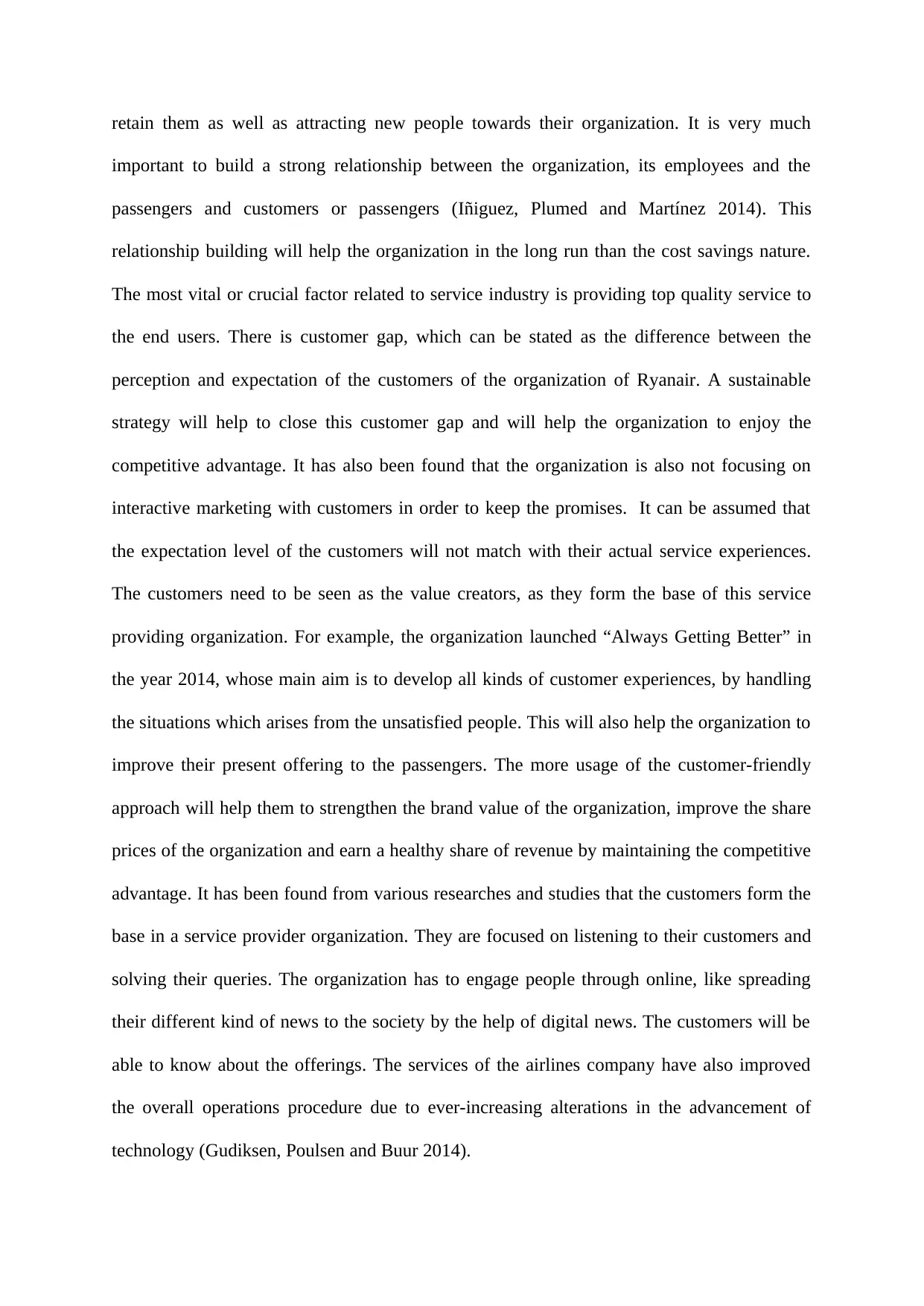
retain them as well as attracting new people towards their organization. It is very much
important to build a strong relationship between the organization, its employees and the
passengers and customers or passengers (Iñiguez, Plumed and Martínez 2014). This
relationship building will help the organization in the long run than the cost savings nature.
The most vital or crucial factor related to service industry is providing top quality service to
the end users. There is customer gap, which can be stated as the difference between the
perception and expectation of the customers of the organization of Ryanair. A sustainable
strategy will help to close this customer gap and will help the organization to enjoy the
competitive advantage. It has also been found that the organization is also not focusing on
interactive marketing with customers in order to keep the promises. It can be assumed that
the expectation level of the customers will not match with their actual service experiences.
The customers need to be seen as the value creators, as they form the base of this service
providing organization. For example, the organization launched “Always Getting Better” in
the year 2014, whose main aim is to develop all kinds of customer experiences, by handling
the situations which arises from the unsatisfied people. This will also help the organization to
improve their present offering to the passengers. The more usage of the customer-friendly
approach will help them to strengthen the brand value of the organization, improve the share
prices of the organization and earn a healthy share of revenue by maintaining the competitive
advantage. It has been found from various researches and studies that the customers form the
base in a service provider organization. They are focused on listening to their customers and
solving their queries. The organization has to engage people through online, like spreading
their different kind of news to the society by the help of digital news. The customers will be
able to know about the offerings. The services of the airlines company have also improved
the overall operations procedure due to ever-increasing alterations in the advancement of
technology (Gudiksen, Poulsen and Buur 2014).
important to build a strong relationship between the organization, its employees and the
passengers and customers or passengers (Iñiguez, Plumed and Martínez 2014). This
relationship building will help the organization in the long run than the cost savings nature.
The most vital or crucial factor related to service industry is providing top quality service to
the end users. There is customer gap, which can be stated as the difference between the
perception and expectation of the customers of the organization of Ryanair. A sustainable
strategy will help to close this customer gap and will help the organization to enjoy the
competitive advantage. It has also been found that the organization is also not focusing on
interactive marketing with customers in order to keep the promises. It can be assumed that
the expectation level of the customers will not match with their actual service experiences.
The customers need to be seen as the value creators, as they form the base of this service
providing organization. For example, the organization launched “Always Getting Better” in
the year 2014, whose main aim is to develop all kinds of customer experiences, by handling
the situations which arises from the unsatisfied people. This will also help the organization to
improve their present offering to the passengers. The more usage of the customer-friendly
approach will help them to strengthen the brand value of the organization, improve the share
prices of the organization and earn a healthy share of revenue by maintaining the competitive
advantage. It has been found from various researches and studies that the customers form the
base in a service provider organization. They are focused on listening to their customers and
solving their queries. The organization has to engage people through online, like spreading
their different kind of news to the society by the help of digital news. The customers will be
able to know about the offerings. The services of the airlines company have also improved
the overall operations procedure due to ever-increasing alterations in the advancement of
technology (Gudiksen, Poulsen and Buur 2014).
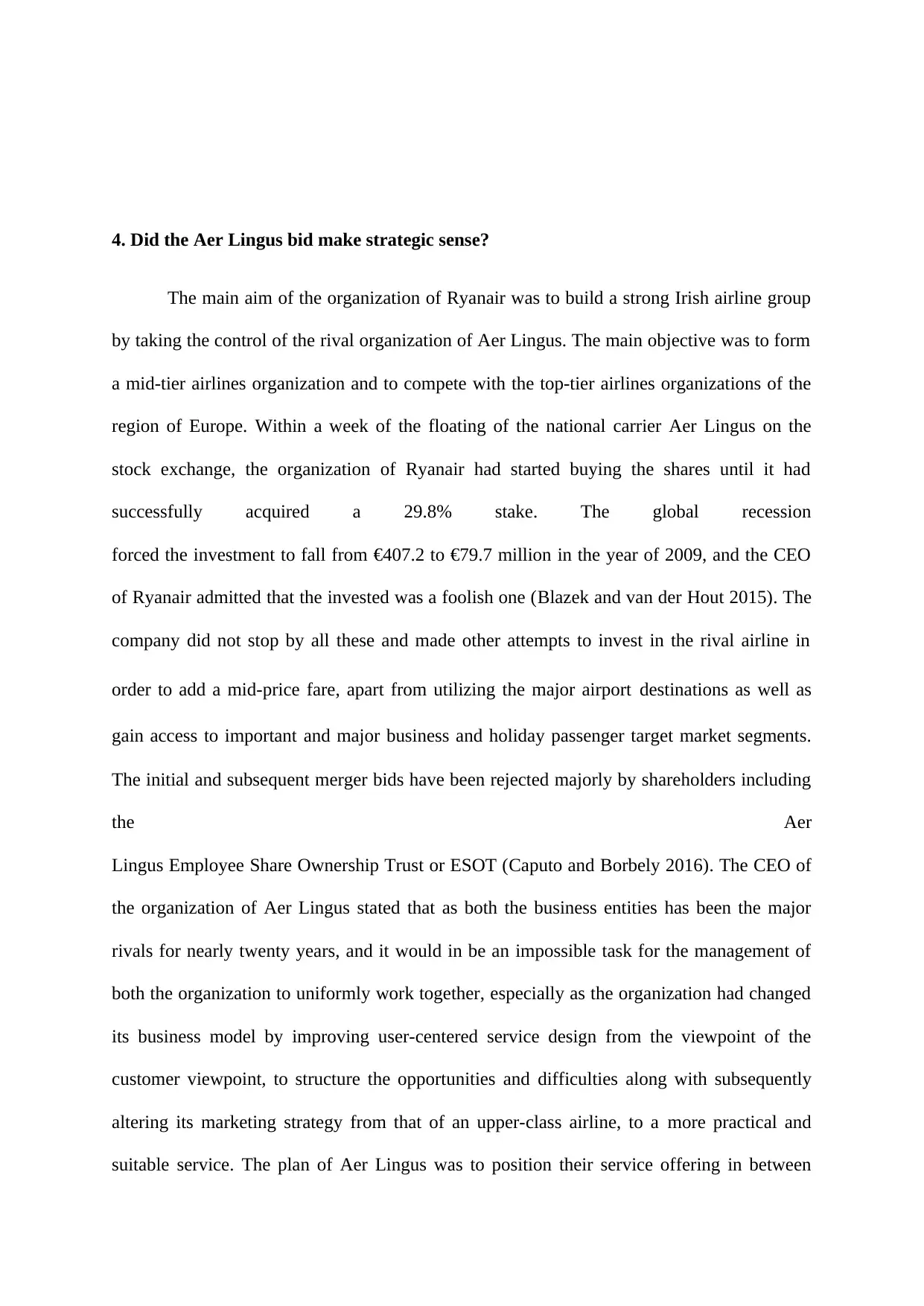
4. Did the Aer Lingus bid make strategic sense?
The main aim of the organization of Ryanair was to build a strong Irish airline group
by taking the control of the rival organization of Aer Lingus. The main objective was to form
a mid-tier airlines organization and to compete with the top-tier airlines organizations of the
region of Europe. Within a week of the floating of the national carrier Aer Lingus on the
stock exchange, the organization of Ryanair had started buying the shares until it had
successfully acquired a 29.8% stake. The global recession
forced the investment to fall from €407.2 to €79.7 million in the year of 2009, and the CEO
of Ryanair admitted that the invested was a foolish one (Blazek and van der Hout 2015). The
company did not stop by all these and made other attempts to invest in the rival airline in
order to add a mid-price fare, apart from utilizing the major airport destinations as well as
gain access to important and major business and holiday passenger target market segments.
The initial and subsequent merger bids have been rejected majorly by shareholders including
the Aer
Lingus Employee Share Ownership Trust or ESOT (Caputo and Borbely 2016). The CEO of
the organization of Aer Lingus stated that as both the business entities has been the major
rivals for nearly twenty years, and it would in be an impossible task for the management of
both the organization to uniformly work together, especially as the organization had changed
its business model by improving user-centered service design from the viewpoint of the
customer viewpoint, to structure the opportunities and difficulties along with subsequently
altering its marketing strategy from that of an upper-class airline, to a more practical and
suitable service. The plan of Aer Lingus was to position their service offering in between
The main aim of the organization of Ryanair was to build a strong Irish airline group
by taking the control of the rival organization of Aer Lingus. The main objective was to form
a mid-tier airlines organization and to compete with the top-tier airlines organizations of the
region of Europe. Within a week of the floating of the national carrier Aer Lingus on the
stock exchange, the organization of Ryanair had started buying the shares until it had
successfully acquired a 29.8% stake. The global recession
forced the investment to fall from €407.2 to €79.7 million in the year of 2009, and the CEO
of Ryanair admitted that the invested was a foolish one (Blazek and van der Hout 2015). The
company did not stop by all these and made other attempts to invest in the rival airline in
order to add a mid-price fare, apart from utilizing the major airport destinations as well as
gain access to important and major business and holiday passenger target market segments.
The initial and subsequent merger bids have been rejected majorly by shareholders including
the Aer
Lingus Employee Share Ownership Trust or ESOT (Caputo and Borbely 2016). The CEO of
the organization of Aer Lingus stated that as both the business entities has been the major
rivals for nearly twenty years, and it would in be an impossible task for the management of
both the organization to uniformly work together, especially as the organization had changed
its business model by improving user-centered service design from the viewpoint of the
customer viewpoint, to structure the opportunities and difficulties along with subsequently
altering its marketing strategy from that of an upper-class airline, to a more practical and
suitable service. The plan of Aer Lingus was to position their service offering in between
⊘ This is a preview!⊘
Do you want full access?
Subscribe today to unlock all pages.

Trusted by 1+ million students worldwide
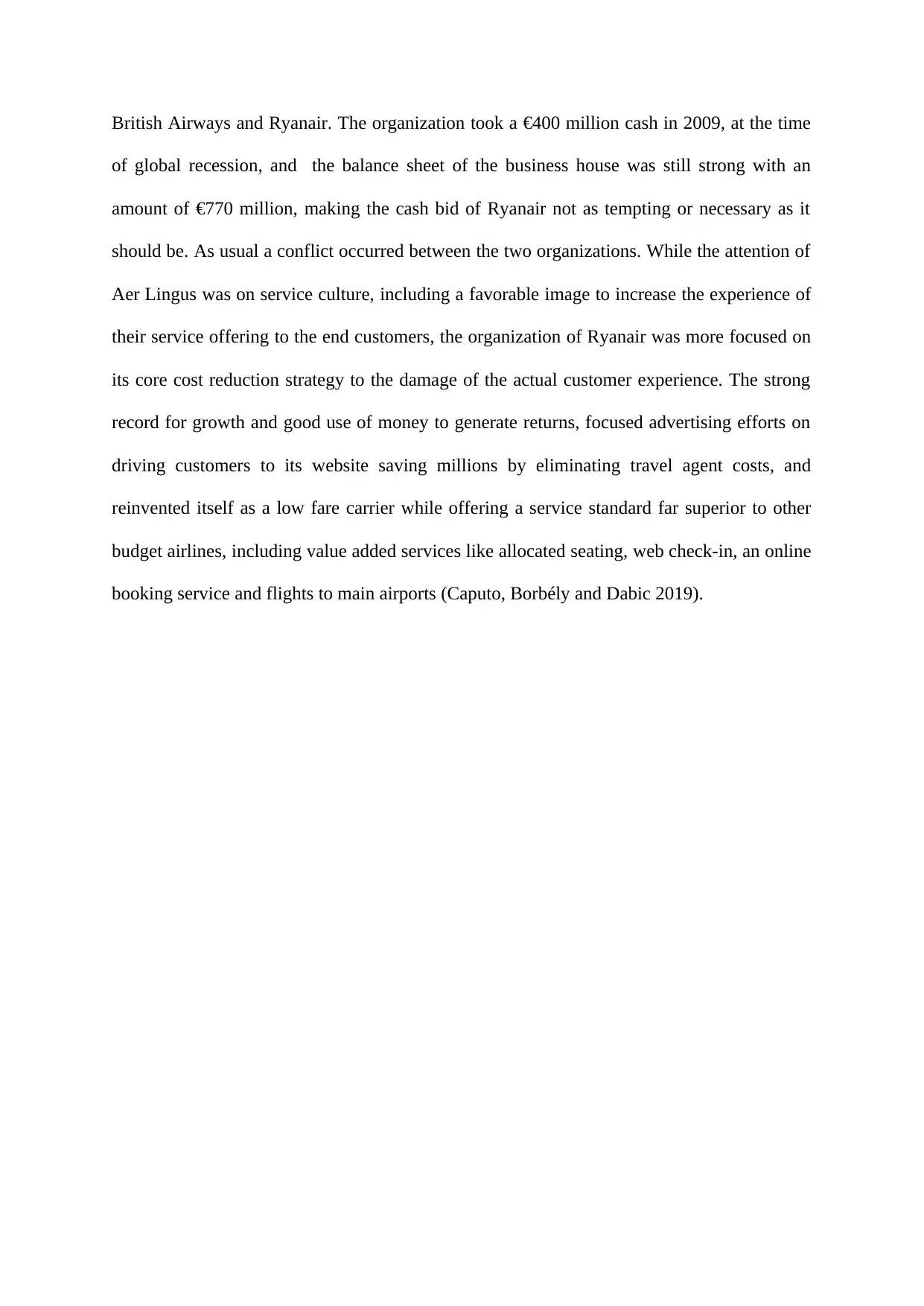
British Airways and Ryanair. The organization took a €400 million cash in 2009, at the time
of global recession, and the balance sheet of the business house was still strong with an
amount of €770 million, making the cash bid of Ryanair not as tempting or necessary as it
should be. As usual a conflict occurred between the two organizations. While the attention of
Aer Lingus was on service culture, including a favorable image to increase the experience of
their service offering to the end customers, the organization of Ryanair was more focused on
its core cost reduction strategy to the damage of the actual customer experience. The strong
record for growth and good use of money to generate returns, focused advertising efforts on
driving customers to its website saving millions by eliminating travel agent costs, and
reinvented itself as a low fare carrier while offering a service standard far superior to other
budget airlines, including value added services like allocated seating, web check-in, an online
booking service and flights to main airports (Caputo, Borbély and Dabic 2019).
of global recession, and the balance sheet of the business house was still strong with an
amount of €770 million, making the cash bid of Ryanair not as tempting or necessary as it
should be. As usual a conflict occurred between the two organizations. While the attention of
Aer Lingus was on service culture, including a favorable image to increase the experience of
their service offering to the end customers, the organization of Ryanair was more focused on
its core cost reduction strategy to the damage of the actual customer experience. The strong
record for growth and good use of money to generate returns, focused advertising efforts on
driving customers to its website saving millions by eliminating travel agent costs, and
reinvented itself as a low fare carrier while offering a service standard far superior to other
budget airlines, including value added services like allocated seating, web check-in, an online
booking service and flights to main airports (Caputo, Borbély and Dabic 2019).
Paraphrase This Document
Need a fresh take? Get an instant paraphrase of this document with our AI Paraphraser
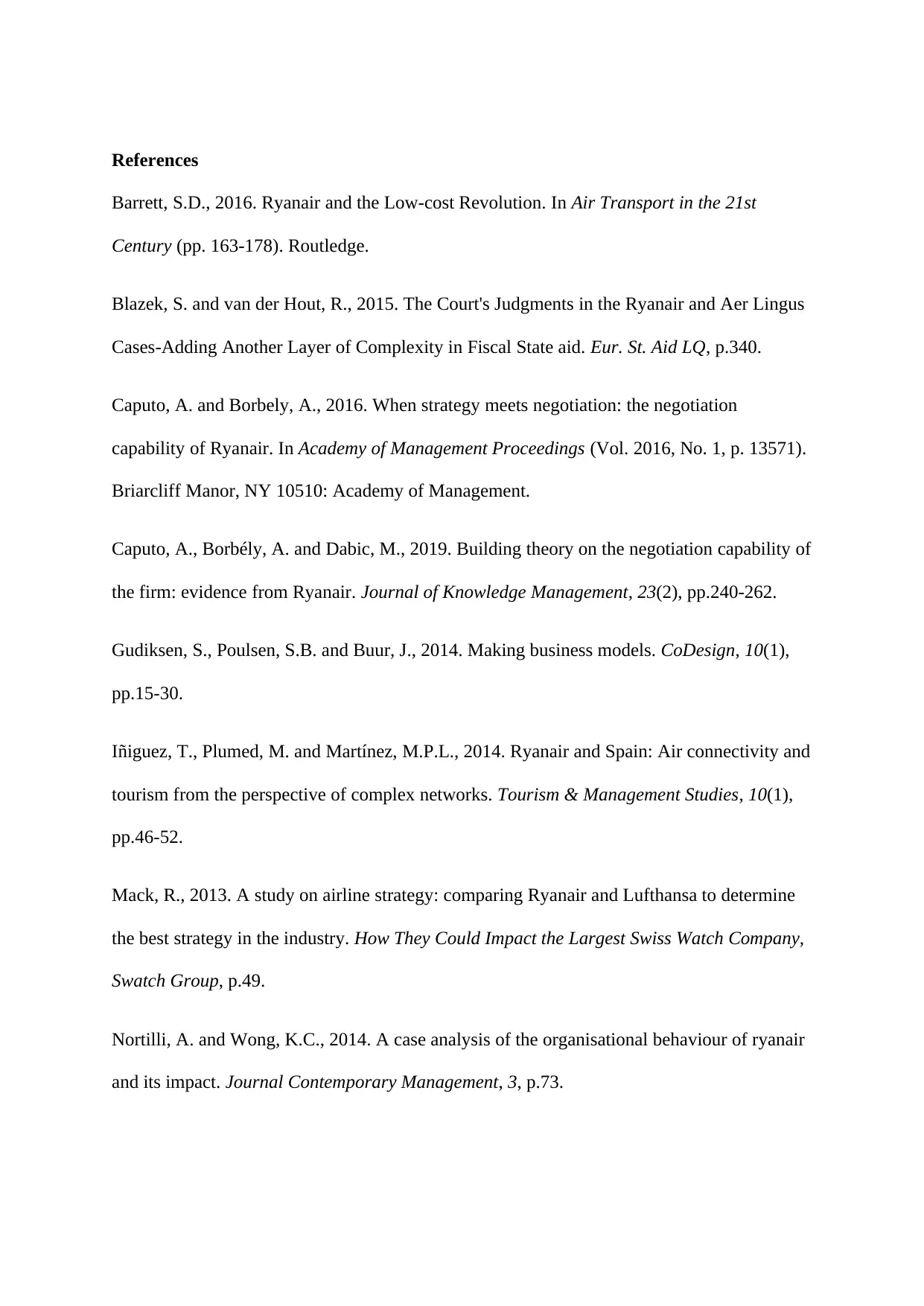
References
Barrett, S.D., 2016. Ryanair and the Low-cost Revolution. In Air Transport in the 21st
Century (pp. 163-178). Routledge.
Blazek, S. and van der Hout, R., 2015. The Court's Judgments in the Ryanair and Aer Lingus
Cases-Adding Another Layer of Complexity in Fiscal State aid. Eur. St. Aid LQ, p.340.
Caputo, A. and Borbely, A., 2016. When strategy meets negotiation: the negotiation
capability of Ryanair. In Academy of Management Proceedings (Vol. 2016, No. 1, p. 13571).
Briarcliff Manor, NY 10510: Academy of Management.
Caputo, A., Borbély, A. and Dabic, M., 2019. Building theory on the negotiation capability of
the firm: evidence from Ryanair. Journal of Knowledge Management, 23(2), pp.240-262.
Gudiksen, S., Poulsen, S.B. and Buur, J., 2014. Making business models. CoDesign, 10(1),
pp.15-30.
Iñiguez, T., Plumed, M. and Martínez, M.P.L., 2014. Ryanair and Spain: Air connectivity and
tourism from the perspective of complex networks. Tourism & Management Studies, 10(1),
pp.46-52.
Mack, R., 2013. A study on airline strategy: comparing Ryanair and Lufthansa to determine
the best strategy in the industry. How They Could Impact the Largest Swiss Watch Company,
Swatch Group, p.49.
Nortilli, A. and Wong, K.C., 2014. A case analysis of the organisational behaviour of ryanair
and its impact. Journal Contemporary Management, 3, p.73.
Barrett, S.D., 2016. Ryanair and the Low-cost Revolution. In Air Transport in the 21st
Century (pp. 163-178). Routledge.
Blazek, S. and van der Hout, R., 2015. The Court's Judgments in the Ryanair and Aer Lingus
Cases-Adding Another Layer of Complexity in Fiscal State aid. Eur. St. Aid LQ, p.340.
Caputo, A. and Borbely, A., 2016. When strategy meets negotiation: the negotiation
capability of Ryanair. In Academy of Management Proceedings (Vol. 2016, No. 1, p. 13571).
Briarcliff Manor, NY 10510: Academy of Management.
Caputo, A., Borbély, A. and Dabic, M., 2019. Building theory on the negotiation capability of
the firm: evidence from Ryanair. Journal of Knowledge Management, 23(2), pp.240-262.
Gudiksen, S., Poulsen, S.B. and Buur, J., 2014. Making business models. CoDesign, 10(1),
pp.15-30.
Iñiguez, T., Plumed, M. and Martínez, M.P.L., 2014. Ryanair and Spain: Air connectivity and
tourism from the perspective of complex networks. Tourism & Management Studies, 10(1),
pp.46-52.
Mack, R., 2013. A study on airline strategy: comparing Ryanair and Lufthansa to determine
the best strategy in the industry. How They Could Impact the Largest Swiss Watch Company,
Swatch Group, p.49.
Nortilli, A. and Wong, K.C., 2014. A case analysis of the organisational behaviour of ryanair
and its impact. Journal Contemporary Management, 3, p.73.
1 out of 8
Related Documents
Your All-in-One AI-Powered Toolkit for Academic Success.
+13062052269
info@desklib.com
Available 24*7 on WhatsApp / Email
![[object Object]](/_next/static/media/star-bottom.7253800d.svg)
Unlock your academic potential
Copyright © 2020–2025 A2Z Services. All Rights Reserved. Developed and managed by ZUCOL.





